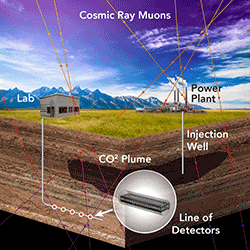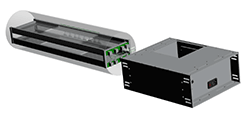Muon detector important for imaging and monitoring carbon dioxide storage sites

Invisible to the naked eye, muons are elementary particles created by the collisions of cosmic rays with molecules in the upper atmosphere. These muons are constantly beaming down on the earth's surface at various angles. Because muons pass through materials, scientists since the 1960s have turned to them to "see" the inside of structures, such as the pyramids of Giza.
Now the muons, once used to explore the inside of pyramids and volcanoes alike, are enabling researchers to see deep underground with a technological breakthrough from PNNL.
By placing detection equipment—about the size of a small car—next to a structure, such as a pyramid, researchers can measure anomalies in the flux of muons that pass through. The anomalies—specifically changes in the number of muons hitting the detectors each second—show a change in density within the structure or object. In the case of a pyramid, anomalies indicated the presence of crypts or hidden chambers.
Due to their large size, current muon detectors can only image the subsurface if they are placed in underground mines or tunnels. To be effectively used to create 3D images of underground carbon dioxide plumes or oil reservoirs, and eventually be able to monitor changes with time, muon detectors need a way to go deeper and "see" more. But how do we get a detector the size of a small car thousands of feet underground?
Researchers at PNNL and their partners have created a borehole-sized muon detector—just five inches in diameter and about two feet long—that can be inserted deep into the earth. This first-of-its-kind device—funded by the DOE Office of Fossil Energy(Offsite link) as part of the Subsurface Technology and Engineering Research (SubTER) Crosscut—is a groundbreaking advancement for underground density imaging.

As no surprise, building such a detector and the computer methods to translate muon anomalies into density images required some active participations from partners:
- University of Hawaii: Customized electronics
- University of Utah: Simulation for various designs
- Los Alamos National Laboratory (LANL): Comparison (benchmark) with large detectors, and computer methods to couple muon and gravity data
- Sandia National Laboratories (SNL): Comparison with large detectors
- Lawrence Livermore National Laboratory: Computer methods to couple muon and seismic data
- Paulsson Inc.: Instrument packaging for downhole use Prototype of the borehole-sized muon detector
Existing large detectors house multiple scintillator planes—layers of a material that produce flashes of light when struck by a muon. The first prototype borehole muon detector consists of 30 horizontal long scintillating rods in two layers and 60 short perpendicular rods in two layers, optical fibers, light sensors, and electronics to detect each muon that that passes through the device. Several computer simulations of muons trajectories have been performed to select the optimal geometry of the different layers. The detector counts the muons but also determine their trajectories which is required to build a 3D density image.
The completed prototype was deployed in PNNL's Shallow Underground Laboratory for an initial successful test in May 2016. It was then sent to LANL in early June to be tested in a tunnel where it will collect data for two months. The research team will compare those data to that from two larger detectors developed by LANL and SNL deployed in the same tunnel.
Designs for the second prototype are well underway. Based on the lessons learned on the first prototype, PNNL researchers, in close collaboration with University of Hawaii, are designing an updated instrument with greater sensitivity and controls for orientation in vertical and horizontal boreholes.
Provided by Pacific Northwest National Laboratory




















